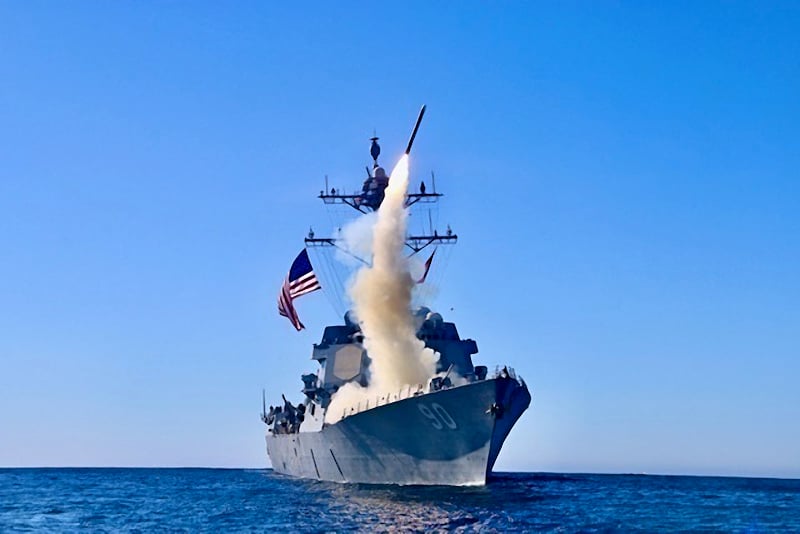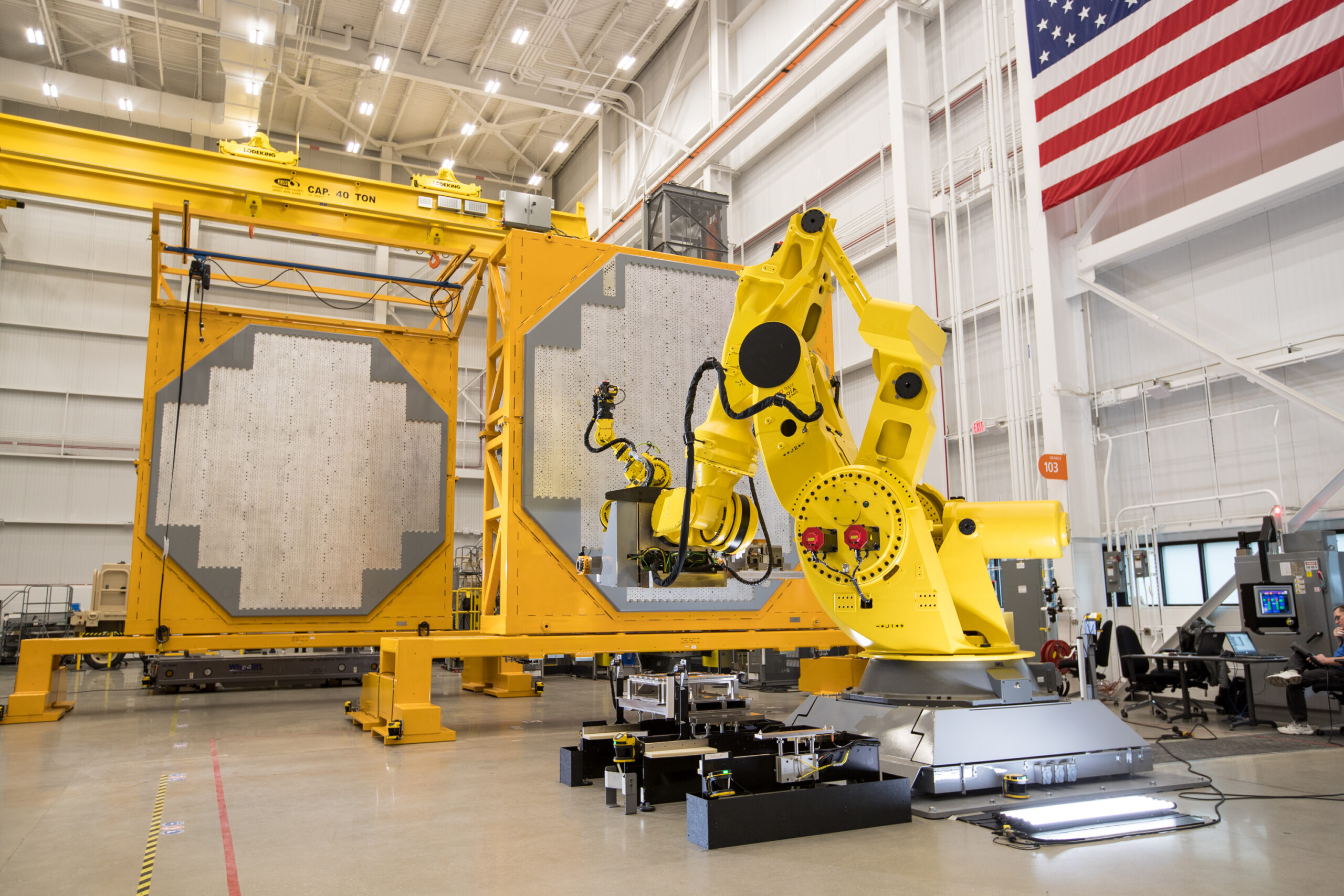
Improved maritime strike variants of the Tomahawk cruise missile includes better navigation and communications that let the Tomahawk strike moving targets at sea.
In this Q&A with Kim Ernzen, vice president of Naval Power at Raytheon, we discuss systems that enable DMO such as the SPY-6 radar for air and missile defense, the Cooperative Engagement Capability sensor network, and Tomahawk Block V.
Breaking Defense: How has DMO evolved since the Marine Corps developed the concept a few years ago?
Ernzen: It’s starting to take shape as the Navy has a better understanding of how to take existing infrastructure and truly turn those assets into the various nodes on the network. When we look at the products that we provide to the Navy—everything from sensors to the effectors and the network behind it, specifically the Cooperative Engagement Capability (CEC) sensor network with integrated fire-control capability that creates a single, integrated real-time composite track air picture—the Navy is pushing us and other industry partners to start getting those systems to talk in a different way so that you can distribute your assets very differently.
One of the things that we’re excited about is future capabilities. For example, our new S-band radar, the AN/SPY-6(V)1, which we call the SPY-6, is coming into the fleet and we’re currently installing it on the first Flight III destroyer, the DDG 125 Arleigh Burke-class guided missile destroyer. SPY-6 provides several advantages over legacy radars, including significantly greater detection range, increased sensitivity, and more accurate discrimination.
It was designed for seven classes of ships, and each variant uses the same hardware and software. This modular construction makes them more reliable and less expensive to maintain, while increasing the number of nodes on the network.
SPY-6 radars are built from individual building blocks called Radar Modular Assemblies, or self-contained radars that come in 2’x2’x2’ boxes. Those boxes stack together to fit the mission requirements of any ship – a feature that makes the SPY-6 family the Navy’s first truly scalable radars that specifically help support DMO missions.
Breaking Defense: What other improved systems are you delivering that help enable DMO?
Ernzen: CEC is the network that the Navy uses for not only command and control but also comms and providing data across the fleet. We continue to work on a multitude of enhancements in that system. We’re improving it as the backbone for the Navy, and are also working on initiatives to scale it down and install it onto potential aircraft in the Navy. This would serve to increase the number of CEC network nodes.
And, of course, we are striving to improve long-range fires. We’re currently working on maritime strike variants for the Tomahawk cruise missile, and have started delivering the Block V upgrades, which includes improved navigation and communications that let the Tomahawk strike moving targets at sea and hit more diverse land targets. This gives you a very capable effector that, once again, gives you another node and more capability for DMO.
Breaking Defense: I’ve heard the term Naval Operational Architectures (NOA), but there’s very little about it online. What exactly is NOA, and where does your technology fit into it?
Ernzen: It’s a philosophy and the overarching intent of how the Navy wants to connect these systems. You’re not going to see it as a line item on a DoD budget, for instance.
What we’re seeing and where we’re supporting the Navy is in continuing to look at how we can optimize our systems. That’s not only for the intent of what a particular product was designed for, but also looking at how we can integrate it with other systems that may be either on ships, submarines, or other platforms.
We’ve also increased our focus on undersea activity because, obviously, the Navy spans all domains that all rely to some extent on the same space, surface, and underwater assets. One of the technical challenges we’re working on is solving the question of how you start to create an undersea network because that’s just as important as what you can see above the water.
Breaking Defense: That’s interesting. I’ve not heard much talk about undersea networks. What would be the challenges of an undersea network? Does the cloud work under the sea?
Ernzen: That’s some of the technological challenges we’re working through. It’s a different medium and you’ve got acoustics that you have to deal with. How do you make sure that you understand the messaging that you’re getting? Current technology doesn’t allow you to be able to hear as far away as what you would potentially like to.
Working in concert with some of our other sister divisions, we’re developing innovative technologies that are starting to show real capability for leveraging a different way of solving the undersea network equation.
Breaking Defense: You’re employing advanced digital tools in the development of the systems we’ve been discussing. How is Raytheon using these tools to enable DMO?
Ernzen: Our industry is obviously heavily focusing on digital transformation and we’re no different. We have been investing millions of dollars over the last several years to ensure we’ve got the right tools. We’ve been on the cutting edge of leveraging agile development and DevSecOps in some of our program areas. We do that frequently as it relates to CEC because the threats continue to evolve quickly. When you can drop software upgrades into existing hardware, you can add the capability much quicker than developing a new piece of hardware. And so we’ve been working tightly with the Navy to see how we really leverage DevSecOps.
We’re also leveraging our digital capability for missile upgrades so we can continue to outpace the evolving threats. It’s definitely something that we embody and are continuing to invest in.
Even though the following example is outside of the Navy, we have an Air Force program that was completely done digitally—the Long Range Standoff (LRSO) strike weapon. That has really culminated all of the efforts that we’ve been doing to date and continues to push us forward as it relates to digital transformation. (Note: In July, the Air Force awarded Raytheon a $3 billion Engineering and Manufacturing Development contract for LRSO, which will replace the 1980s-era AGM-86B Air Launched Cruise Missile. According to the Air Force, the aging ALCM will continue to face increasingly significant operational challenges against emerging anti-access/area-denial threats until replaced.)
Breaking Defense: Briefly tell us a bit about your digital modeling and simulation as part of your digital transformation efforts.
Again, as we talk about overarching architectures like DMO, we’re able to sit down with the Navy and look at not only our systems but other systems that they have in the fleet to really understand how we can tweak things that can make a huge difference. We have been investing heavily in our modeling and simulation capabilities so that we make sure we understand what it is the Navy needs industry to provide. The goal is to understand the threats, how they are evolving, and how we can then evolve our capabilities to outpace them.

Raytheon’s SPY-6 air- and missile-defense system is built of modular blocks for Distributed Maritime Operations on both manned and unmanned vessels.
Breaking Defense: Tell me about the tangible benefits and applications that are helping the Navy realize its objectives for DMO.
Ernzen: We talked a little bit about SPY-6, and one of the key parts of that program is giving the Navy the ability to put the air- and missile-defense system on both manned and unmanned vessels. The beauty of SPY-6 is that it has an incredibly scalable architecture, and it’s built on a foundation of modules that can scale up or down, as we discussed earlier. It really gives the Navy flexibility.
Another of our systems that facilitates DMO is the Naval Strike Missile, which was developed for over-the-horizon defense of Littoral Combat Chips and future frigates, and is also suited for land-attack missions because it can climb and descend with the terrain.
We’re now starting to see the missile span different services. Since its initial instantiation onto the Littoral Combat Ship, we now are working in concert with the Marine Corps to help them apply the system to its expeditionary force. Integrating the Naval Strike Missile into its force structure lets the marines share costs and interoperability with the Navy. This provides additional connectivity for DMO because you’ve got one product that can span multiple services with different launching capabilities.
In addition to evolving the CEC that we discussed earlier, we’ve got a multitude of Navy and Marine Corps products that play an important role in DMO.
Breaking Defense: Final thoughts?
Ernzen: Raytheon understands what the Navy wants to do with Distributed Maritime Operations. We understand the overarching architectures of NOA, and we think we’ve got a lot of the components that provide that connective tissue. We continue to look forward to partnering with the Navy to evolve these products so that they truly can provide the Navy with capabilities to perform Distributed Maritime Operations.






















